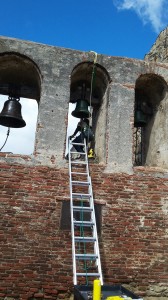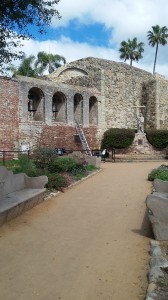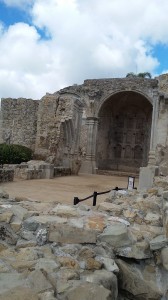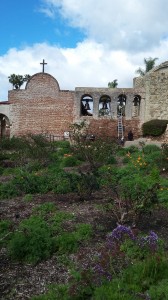SAN JUAN CAPISTRANO MISSION
SAN JUAN CAPISTRANO MISSION
By Charles N. Stevens
Photos by Dolores Seidman
We hadn’t been to the San Juan Capistrano Mission in many years, so we were looking forward to seeing it again. It was a fine day for it, the skies mostly clear with a few lumpy clouds, the air crisp and fresh. Our first view after walking through the gate was of a large lemon tree heavy with fruit, the time-ravaged old buildings in the background. We strolled along the gravel paths among more trees and flower beds, noting the condition of the buildings, the plaster having fallen off revealing the bricks and rocks underneath.
It was too early in the year for the return of the swallows, but there was a large crow strutting down one of the paths. Being inside the compound was peaceful and quiet; the soft sound of traffic outside the only hint we were in the modern age. I noticed that the Spanish tile roofs were tinted with green algae brought about by winter rains and age. I sat and looked at one of the buildings, particularly the heavy timbers around the doors and the vertical wooden slats in the windows. The ages have taken their toll on the buildings, but when one considers that the mission was begun in 1776, it is in remarkable shape. Repairs are being made. In one section, three men were busy restoring large, very old bells, working meticulously to remove any corrosion that might affect the sound of the bell.
We entered the soldier’s barracks noting the crude cots constructed of wood and leather, rustic tables and a kitchen with all the usual kitchen pottery. Outside, a very large boulder contained cavities that had been bored into it to grind grains. It was used by the Acjachemen Indians before the mission was built. Each hole was filled with water from the recent rains. We walked around to the site of the original church. Built by the local Indians it was felled by a powerful earthquake. Only part of the arches has survived. A new church was built in the northern part of the compound.
Moving on, we walked toward the north where a huge square or courtyard was surrounded on each side by low buildings with archways. Looking at those series of arches as they fade away in perspective is quite a sight. We passed a huge wine vat then great pots where workers turned fat into soap and candles. Other large brick-lined depressions were used for the tanning of hides. The mission was largely self-sufficient.
The original fathers and soldiers who established the mission owed much to the Indians that they pressed into service to help them with all their labor. The last room we saw is dedicated to the Indians, highlighting their toil in maintaining the mission.

Workers are repairing the bells and all the structures as the l776 Mission at San Juan Capistrano.

Near the bells is a statue of Father Serra, Founder of the California Missions.

The old church was destroyed in an earthquake.

Flowers enhance the beauty of he old brick and stone structure of the museum.
MONTEREY PARK AUTHOR PUBLISHES 4th BOOK – Seeking More of the Sky: Growing Up in the 1930’s:
Charles “Norm” Stevens, a 43 year resident of Monterey Park has recently published his 4th book: Seeking More of the Sky: Growing Up in the 1930’s. This is the story of a young boy growing up in Inglewood, California in the l930’s. This was a time during the depression when unemployment was affecting many and the banks were closed, while the clouds of war were gathering in Europe. But he was lucky enough to be raised in a loving family, the power of that love reflected throughout his stories.
Stevens is the author of three previous books about his experiences during WWII:
An Innocent at Polebrook: A Memoir of an 8th Air Force Bombardier (Story of his 34 bombing missions from his base at Polebrook, England over Germany and France)
The Innocent Cadet: Becoming A World War II Bombardier (A prequel to the first, telling of his training in the U.S. before going overseas into combat.)
Back from Combat: A WWII Bombardier Faces His Military Future from Combat: (This book details the time from when he returned from combat in England until the end of the war.)
He is known to the readers of The Citizen’s Voice as the author of Travel Log Articles including “Cruising the Rhine and Mosel”,” Best of the West”, “In Search of Snow” , “From Paris to Normandy on the Seine”, and “Exploring New York”. He is retired, having taught for 32 years, primarily in the Montebello Unified School District.
Those interested in purchasing an autographed copy of any of his books, may contact the author at 323-721-8230 or Normstevens24@gmail.com.



